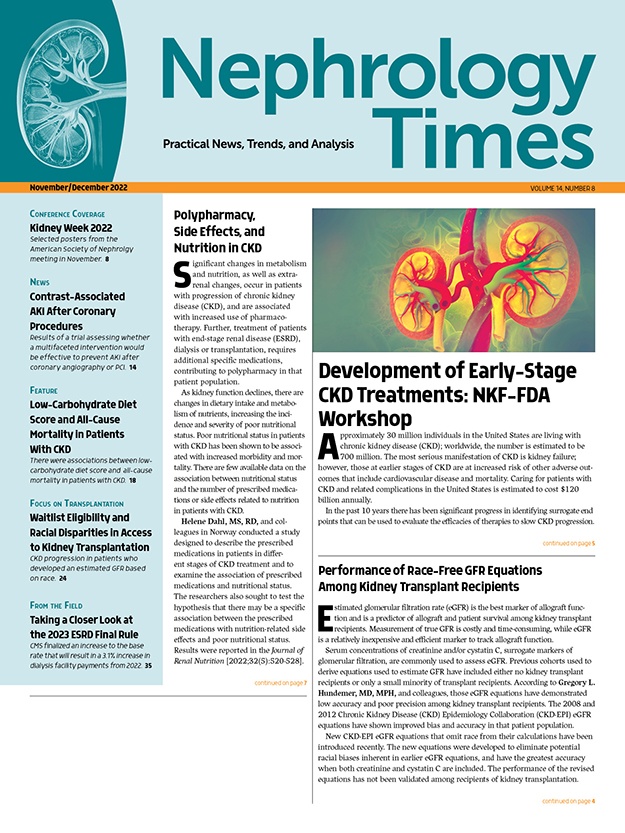
Among patients with end-stage renal disease (ESRD) on hemodialysis, mineral bone disease (MBD) is a nontraditional cardiovascular risk factor that contributes to high mortality rate in that patient population. Hyperphosphatemia and related increases in parathyroid hormone (PTH) are each independently associated with mortality in patients with MBD.
It is known that chronically elevated serum phosphate contributes to structural changes in blood vessels including vascular calcification. According to Jinwoo Jung, MD, and colleagues, there is emerging evidence that elevated serum phosphate is also associated with other functional abnormalities of the blood vessels that may be more easily reversible.
The researchers conducted a cross-sectional study among patients with hypertension on maintenance hemodialysis to test the hypothesis that there would be an independent association between elevated serum phosphate and blood pressure, as well as with measurements of vasoconstriction and markers of endothelial cell dysfunction (ECD). Results were reported online in BMC Nephrology [doi.org/10.1186/s12882-022-02918-0].
Baseline data from a previously conducted prospective cohort of hypertensive ESRD patients on maintenance hemodialysis that included a predefined subset with recurrent intradialytic hypertension were used for the current analysis. Inclusion criteria were age >18 years, hemodialysis vintage >1 month, and peri-dialytic hypertension, defined as pre-hemodialysis systolic blood pressure >140 mm Hg or post-hemodialysis systolic blood pressure >130 mm Hg.
Measurements of total peripheral resistance index (TPRI, noninvasive cardiac output monitor) and plasma levels of endothelial-1 (ET-1) and asymmetric dimethylarginine (ADMA) were obtained before and after a midweek hemodialysis treatment, as were blood pressure measurements. Generalized linear regression analyses were used to determine independent associations between serum phosphate and blood pressure, TPRI, ET-1, and ADMA, while controlling for demographic variables, PTH, and interdialytic weight gain.
The cohort for the current analysis included 54 patients with complete data available (serum phosphate and the outcomes of pre-hemodialysis blood pressure, TPRI, ET-1, and ADMA, as well as other analyzed covariates). Sixty-one percent were male and 63% had diabetes. Nearly all were receiving at least one oral phosphate binder (56% on calcium-containing binders, 41% on non-calcium-containing binders). Eighty percent were receiving some form of active vitamin D and 33% were receiving cinacalcet. Phosphate levels were collected from a range of 0 to 32 days from the time the blood pressure, TPRI, ET-1, and ADMA measurements were obtained. Mean serum phosphate, calcium, and PTH levels were 1.90 mmol/L, 2.29 mmol/L, and 631 ng/L, respectively.
There were significant correlations between serum phosphate and systolic blood pressure for both the supine and the seated measurements taken prior to hemodialysis (r=0.3; P=.03; and r=0.4; P=.002, respectively). There were no significant correlations between serum phosphate and systolic blood pressure for the supine and seated measurements taken following hemodialysis.
For the supine and seated diastolic blood pressure measurements prior to hemodialysis, there were significant correlations with serum phosphate (r=0.5; P<.0001; and r=0.5; P=.0003, respectively). There were also significant correlations between serum phosphate and post-hemodialysis seated and supine blood pressure measurements taken following hemodialysis (r=0.4; P=.003; and r=0.4; P=.002, respectively).
In a model that controlled for demographic variables, there were positive associations between serum phosphate and diastolic blood pressure as well as systolic blood pressure, although the significance was attenuated in systolic blood pressure. In models that included PTH and percentage of interdialytic weight gain, the positive association between serum phosphate and diastolic blood pressure persisted; the significant association between serum phosphate and systolic blood pressure remained a trend.
The Pearson correlation coefficients for serum phosphate with pre-hemodialysis TPRI, ET-1, and ADMA were 0.3 (P=.01), 0.4 (P=.007), and 0.3 (P=.04), respectively. There were independent associations between serum phosphate and higher TPRI and ET-1 in models that included demographic variables, PTH, and weight gain. There was no association between serum phosphate and ADMA. In the univariate Pearson correlation analysis, PTH was positively associated with AMDA (r=0.3; P=.01); the statistical significance was slightly attenuated in the Spearman correlation and with the regression analysis.
The researchers cited some limitations to the study, including the relatively small sample size and the observational design that limited the ability to draw conclusions regarding causality. Further, the study utilized ET-1 and AMDA as biomarkers for ECD because there were no alternative measurements. Finally, measurements of serum phosphate and other hemodialysis laboratory values were gathered in the context of routine clinical care and did not occur on the same data as the blood pressure and TPRI measurements.
In conclusion, the authors said, “We found that there is a positive association between serum phosphate and peridialytic blood pressure. The association with diastolic blood pressure was particularly strong and was independent of PTH, interdialytic weight gain, and other variables. We found that phosphate was also related to prehemodialysis vasoconstriction and ECD markers, although the association with ADMA was not fully independent of other factors. These findings require further investigation to determine the hemodynamic benefits of aggressive phosphate lowering in ESRD and even possible in pre-ESRD chronic kidney disease. They also introduce the possibility of more targeted approaches to blood pressure management among patients with refractory hyperphosphatemia. Such research will require comprehensive assessment of the numerous mediators of MBD.”
Takeaway Points
- Researchers reported results of a study designed to test the hypothesis that elevated serum phosphate would be independently associated with blood pressure and with measurements of endothelial cell dysfunction (ECD) and measures of vasoconstriction in hypertensive hemodialysis patients.
- The study found independent associations between serum phosphate concentration and higher predialysis blood pressure, vasoconstriction, and markers of ECD.
- The findings demonstrated an additional negative impact of hyperphosphatemia on cardiovascular health beyond vascular calcification.







 © 2025 Mashup Media, LLC, a Formedics Property. All Rights Reserved.
© 2025 Mashup Media, LLC, a Formedics Property. All Rights Reserved.